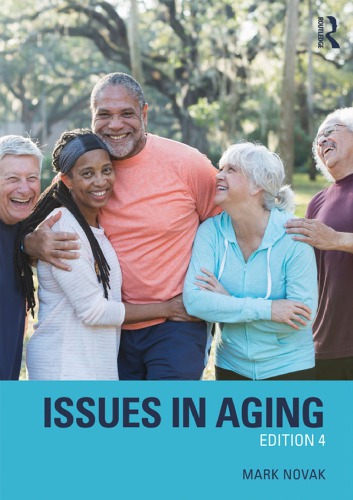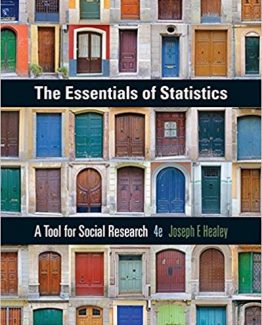Issues in Aging 4th Edition by Mark Novak, ISBN-13: 978-1138214750
[PDF eBook eTextbook]
- Publisher: Routledge; 4th edition (February 7, 2018)
- Language: English
- 800 pages
- ISBN-10: 1138214752
- ISBN-13: 978-1138214750
Issues in Aging combines social, psychological, biological, and philosophical perspectives to present a multifaceted picture of aging. Novak illustrates both the problems and the opportunities that accompany older age. This text helps students understand the tremendous variability in aging and introduces them to careers working with older adults.
This new edition reflects the continued changes in the way we age. The fourth edition has been updated to include emerging issues in aging. These include the prevalence of HIV/AIDs in later life, current research on mental potential in old age, the creation of age friendly cities, and new options for end of life care.
Each chapter begins with a set of learning objectives to guide students in their reading, and concludes with a list of main points, questions for discussion or study, suggested readings, and relevant web sites to consult. Each chapter also includes up to date charts and graphs as well as key terms to help students understand the issues presented. Break out boxes reveal the human side of aging through the stories of individuals in real life and in the media.
Table of Contents:
Title
Copyright
CONTENTS
DETAILED CONTENTS
Preface
Chapter 1 Aging Today
Why Study Aging?
Ageism
Culture as a Source of Ageism
The Media as a Source of Ageism
Lack of Knowledge as a Source of Ageism
Some Facts on Aging Today
Victimization by Fraud
Effects of Victimization
Fear of Crime
Ageism and the Workplace
The Ageless Self: Another Form of Ageism
Ageism and the Third Age
Responses to Ageism
Change on the Horizon
The Media
The Senior Market: A New Image of Aging
Education Programs
Intergenerational Programs
Legislation and Social Action
Conclusion
Summary
Discussion Questions
Notes
Suggested Reading
Websites to Consult
Chapter 2 Theories and Methods
The Study of Aging in the Past
Gerontology Research Today
Is Gerontology a Discipline?
Theories of Aging
Two Levels of Theories
Three Theoretical Perspectives
Interpretive Perspective
Critique of the Interpretive Perspective
Functionalist Perspective
Age Stratification Theory: An Example of the Functionalist Perspective
Individual Aging
Societal Change
Critique of the Functionalist Perspective
The Life Course Perspective: A More Complex Functionalist Model
Non-normative Life Events
Normative, History-Graded Life Events
Normative, Age-Graded Life Events
Summary of the Life Course Perspective
Conflict Perspective
Critique of the Conflict Perspective
New Developments in Theory
Research Issues and Methods
APC Effects: A Challenge to Gerontology Researchers
Experimental Research
Cross-Sectional Designs
Longitudinal Designs
Quantitative and Qualitative Methods
The Humanities
Information Literacy: The Challenge of the Internet
Ethical Issues in Research
Policy and Programs as the Outcome of Research
The Future of Gerontological Theory and Methods
Conclusion
Summary
Discussion Questions
Suggested Reading
Websites to Consult
Chapter 3 Demography
Introduction
The Challenge of Population Aging
What Is Population Aging?
The Demographic Transition
Three Types of Societies and Population Aging
The Less Developed Nations
China: A Case Study of Population Aging in a Developing Nation
The Least Developed Nations
Ghana: A Case Study of Population Aging in a Least Developed Nation
Summary of Aging in Developing and Least Developed Nations
The Developed Nations
Japan: A Case Study of Population Aging in a Developed Nation
Population Aging in the United States
Increased Numbers of Older People
Increased Median Age of the Population
Increased Proportion of Older People
Measuring Trends
The Causes of Population Change
Migration
Death Rates
Birth Rates
The Challenges of an Aging Population
The Aging of the Older Population
Ethnic and Racial Variations
Regional Distribution
Accumulation
Recomposition
Congregation
Interstate Migration
Amenity Migration
Retirement
Moderate Disability
Major Chronic Disability
Urban–Rural Distribution
Changes in the Sex Ratio
The Impact of Population Aging
Support (or Dependency) Ratios
Critique of Dependency Ratios
Conclusion
Summary
Discussion Questions
Note
Suggested Reading
Websites to Consult
Chapter 4 Personal Health and Well-Being
Biological Aging
The Effects of Aging on Body Systems
Musculoskeletal System
Sensory Changes
Taste, Smell, and Touch
Sight
Hearing
Personal Health and Illness
Changes in Health Status
Limits on Activity Due to Physical Decline
Coping With Physical Change
Improvements in Technology
Computer Technology as a Form of Functional Support
Assistive Devices as a Form of Functional Support
Improvements in the Environment
Improvements in Self-Care
Improvements in Lifestyle
Decreased Smoking
Better Nutrition
Exercise
Stress Reduction
Compression of Morbidity Hypothesis
Successful Aging
Rowe and Kahn’s Model of Successful Aging
The SOC Model of Successful Aging
A Life Course Model of Successful Aging
Anti-aging Medicine and Science
Social Inequality and Personal Health
Health Literacy
Conclusion
Summary
Discussion Questions
Suggested Reading
Websites to Consult
Chapter 5 The Psychology of Aging
Memory and Intelligence
Memory
New Approaches to the Study of Mental Function
Memory and Everyday Life
Experience and Mental Function in Later Life
Memory and Everyday Life: The Study of Reading
Summary of Memory Research
Intelligence
New Models of Mental Ability in Later Life
Plasticity and Cognitive Reserve
Stimulating the Brain for Growth in Later Life
Improving Mental Performance
A Large-Scale Training Program
Social Engagement and Mental Function
Physical Exercise and the Brain
Summary of Findings on Aging and Mental Potential
The Study of Wisdom in Later Life
Creativity
Creativity as Measured by Great Works
Creativity as Personal Expression
Self-Development in Later Life
Spirituality: The Search for Meaning in Later Life
Social Psychological Change
Disengagement Theory
Activity Theory
Continuity Theory
Psychological Disorders: Abnormal Aging
Organic Brain Disorders
Intellectual and Developmental Disability
Cognitive Impairment in Later Life
Functional Disorders
Loneliness
Depression and Suicide
Depression
Suicide
Conclusion
Summary
Discussion Questions
Suggested Reading
Websites to Consult
Chapter 6 Race and Ethnicity
Who Are the Minority Elderly?
Why Study Minority Aging?
Demographic Characteristics of Dominant and Minority Group Elders
Whites: The Dominant Group Older Population
Diversity of the Minority Population
Aging of the Minority Population
Three Theories on Minority Group Aging
Multiple Jeopardy
Critique of Multiple Jeopardy Theory
Leveling Perspective
The Life Course Perspective
Institutional Completeness: An Example of Life Course Differences
Structured Inequality and Personal History
The Impact of Minority Group Membership on Aging
A Look at Four Minority Groups
African Americans
Health
Income
Family and Community Life
Social Support
African American Men
The Future of African American Aging
Hispanic Americans
Health
Elderly Hispanics: The Paradox of Poverty, Good Health, and Long Life
Income
Poverty
Family and Community Life
The Future of Hispanic American Aging
Asian Americans
Health
Income and Poverty
In Dollars
Family and Community Life
The Future of Asian American Aging
American Indians and Alaskan Natives (AIAN)
Health and Income
Family and Community Life
The Future of American Indian Aging
Responses to Minority Group Aging
Future Issues
Conclusion
Summary
Discussion Questions
Notes
Suggested Reading
Websites to Consult
Chapter 7 The Health Care System
Three Models of Health Care
The Medical Model
The Social Model
The Health Promotion Model
The U.S. Health Care System Today
Medicare
The Structure of The Program
Medicare Costs and Funding
Medicaid
Employer-Sponsored Health Care Plans
Medigap and Long-Term Care Insurance
The Health Care System and the Cost of Care
Cost of Care and the Older Population
Medicare Costs
Medicaid Costs
The Rising Personal Cost of Health Care
Public Dissatisfaction
Health Care Reform: National Legislative Action 2010
Summary of the Legislation
Structural Flaws in the System
Long-Term Care: A Response to Older People’s Needs
Institutional Care
Community-Based Services
Adult Day Care
Respite Services
Home Health Care Programs
Changes in Funding to Control Costs
Managed Care: Alternative Delivery Methods
Managed Care With a Medical Focus
Managed Care With a Community Focus
Disease Prevention and Health Promotion
Beyond Fitness and Personal Health Promotion
Future Issues in Health Care
Availability
Accessibility
Coordination
Conclusion
Summary
Discussion Questions
Notes
Suggested Reading
Websites to Consult
Chapter 8 Finances and Economics
Introduction
Historical Development of the U.S. Pension System
The U.S. Retirement Income System Today
Level One: Social Security
Who Gets Social Security?
A Privatized Retirement Income System: The Cure Worse Than the Disease?
Supplemental Security Income
Level Two: Employment Pensions
Individual Pension Plans
Defined Contribution Pension Plans
The Cost of Living (a Long Time)
Level Three: Personal Assets and Other Income
The Impact of the Retirement Income System on Older People’s Incomes
Inequality in Later Life
Age Differences and Income
Gender and Income
Marital Status and Income
Minority Status and Income
Further Effects of Poverty
Pension Reform
Social Security Reform
Family Care
Spousal Pensions
Widows’ Benefits
Income Limits
Supplemental Security Income Reform
Improved Benefits
Improved StateSupplements
Higher Enrollment Rates
Private Pension Reform
Vesting
Portability and Indexing
Better Private Plan Insurance
The Future
Conclusion
Summary
Discussion Questions
Suggested Reading
Websites to Consult
Chapter 9 Retirement and Work
The Social Origins of Retirement
Retirement in the United States Today
A Note on Retirement and the Great Recession
Labor Force Participation
Women and Retirement
Minorities and Retirement
Alternatives to Retirement
Early Retirement
Partial Retirement
Second Careers
Encore Careers
Personal Responses to Retirement
Preretirement Planning (PRE)
Social Structures and Retirement
The Dual Economy
Displaced Workers
The Challenge of Workforce Reentry
The Future of Retirement
Conclusion
Summary
Discussion Questions
Suggested Reading
Websites to Consult
Chapter 10 Housing and Transportation
Introduction
Living Arrangements
An Ecological Model of Housing
Housing Options
Single-Family Homes
Home Modification
Home Equity Conversion Loans (Reverse Mortgages)
Apartment Living
Age Segregation vs. Age Integration
Normal Design vs. Special Design
Congregate Housing and Assisted (Apartment) Living
Congregate Housing
Assisted Living Apartments
Subsidized Housing
Single Room Occupancy
Supportive Housing
Board and Care Homes
Nursing Homes
Accessory Dwelling Units
Home Sharing
Retirement Communities
Naturally Occurring Retirement Communities (NORCs)
Planned Retirement Communities
Cohousing
Continuing Care Retirement Communities
Low-Income, Rural, and Minority Housing
Homelessness
The Future of Housing
Transportation
Public Transportation
Private Transportation
Age-friendly Communities
Conclusion
Summary
Discussion Questions
Note
Suggested Reading
Websites to Consult
Chapter 11 Leisure, Recreation, and Education
Introduction
Leisure
Age and Leisure
Gender and Leisure
Minority Status and Leisure
Leisure Education
New Activities in Old Age
Outdoor Recreation
Fitness, Health, and Well-Being
Programs That Overcome Barriers to Active Living
Masters Athletes and the Senior Olympics
Senior Centers
Education
Formal Higher Education
Informal Educational Options
Road Scholar (Elderhostel)
Lifelong Learning Institutes
The Future of Education for Older People
Community Service and Volunteer Work
Volunteer Opportunities
The Senior Corps
The Peace Corps
The Experience Corps
Conclusion
Summary
Discussion Questions
Suggested Reading
Websites to Consult
Chapter 12 Family Life and Relationships
Marriage and Widowhood
Marital Status
The Advantages and Disadvantages of Marriage
Remarriage
Common-Law Unions and Cohabitation
Divorce
Lifelong Singlehood
Widowhood
Male and Female Responses to Widowhood
Future Research Questions
Dating
Sexuality
Sexuality in Long-Term Care Settings
Physical Changes and Sexual Adaptations
Gay and Lesbian Older Adults
Grandparenting
The Grandparent-Grandchild Relationship
Grandparenting and New Family Structures
Grandparents as Surrogate Parents
The Future of the Family
Conclusion
Summary
Discussion Questions
Suggested Reading
Websites to Consult
Chapter 13 Social Support
What Is Informal Social Support?
Family Life and Family Supports
Informal Supports for Older People
Three Models of Informal Support
The Role of Formal Supports
Community Care
Spousal Support
Adult Children as a Source of Support
Siblings as a Source of Informal Support
Supports for Childless Older People
Friends and Neighbors
Pets as a Source of Social Support
Minority Differences in Social Support
Technology and Social Support
Caregiving
Gender Roles and the Challenge of Caregiving
Caregiver Burden
The Rewards of Caregiving
Care for the Caregiver
The Future of Informal Support
Eldercare and the Workplace
Older People as Family Supporters
The Future of Social Supports
Elder Abuse and Mistreatment
Theories of Abuse and Risk Factors
Elder Abuse Interventions and Policies
Future Issues in Elder Abuse
The Future of Social Supports
Conclusion
Summary
Discussion Questions
Suggested Reading
Websites to Consult
Chapter 14 Death and Dying
Death and Society
Death in Old Age
The Experience of Dying in Old Age
Institutional Death
Changes in the Treatment of the Dying
Stages of Death and Dying
Hospice Care
Hospice Program Goals
Palliative Care
Palliative Care for the Elderly
Ethical Issues
Advance Directives
Minorities and Advance Directives
Beyond Advance Directives: The Importance of Communication
New Methods of Communication
Euthanasia and Physician-Assisted Suicide
Mourning and Grief
Widowhood and Bereavement
Supports for Widows and Widowers
Conclusion
Summary
Discussion Questions
Suggested Reading
Websites to Consult
Chapter 15 Politics and Policies
Voting
Participation Trends Among Older Voters
Will Older People Form a Voting Bloc?
Holding Political Office
Advocacy
The Limits of Advocacy
The Medicare Catastrophic Coverage Act and the Medicare Modernization Act: Two Case Studies in Senio
The Medicare Catastrophic Coverage Act
The Medicare Modernization Act
Activism
Government and Aging Policy
The Older Americans Act
Generational Equity
Conflict Ahead?
Ideology and Aging Policy
Civic Engagement
The Future of Aging, Politics, and Policy
Conclusion
Summary
Discussion Questions
Suggested Reading
Websites to Consult
Works Consulted
Glossary of Terms
Index
What makes us different?
• Instant Download
• Always Competitive Pricing
• 100% Privacy
• FREE Sample Available
• 24-7 LIVE Customer Support





